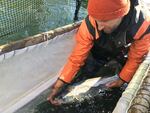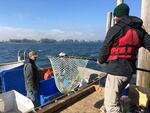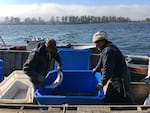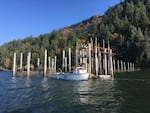Watch this Oregon Field Guide story to see how a fish trap that was outlawed for catching too many fish has been reinvented to protect endangered wild salmon.
About half the salmon swimming up the Columbia River come from hatcheries, and most of them are raised to be caught by fishermen. The rest are wild, and many of them are protected under the Endangered Species Act.
For years, Oregon and Washington have been searching for the best way to catch more hatchery fish while letting the wild fish return unharmed to their spawning grounds. Now, one group says they've found it.
Fish traps were banned on the Columbia more than 80 years ago. But advocates with the Wild Fish Conservancy are revisiting the idea as a new, sustainable way to separate hatchery salmon from wild fish.
At a site near Cathlamet, Washington, about 40 miles upriver from the mouth of the Columbia, Wild Fish Conservancy biologist Adrian Tuohy stood hip deep in water in a cage just below the surface of the Columbia River.
He turned a crank that funneled a mix of hatchery and wild fish from a holding pen into the cage. The fish were corralled in the river by a wall of netting, stretched across a network of pilings that reach out about 30 yards from the bank. Now, they were swimming around him — so close he could pick out the hatchery fish one by one.

Fish trap operators can pick out the hatchery salmon for harvest and release the wild salmon so they can return to their spawning grounds.
Cassandra Profita / OPB
He pulled out all the fish that were missing the secondary fins on their backs, called the adipose fin. That fin is clipped from hatchery fish. Then, he opened a door in the underwater well so the wild fish — with the telltale fins on their backs — could swim back out to the river.
“And the fish swim out for the most part untouched,” Tuohy said. "That’s the beauty of this gear, in contrast to other gear types, is you’re able to successfully release threatened and endangered fish unharmed.”
So far, research has found about 95 percent of the steelhead and 99 percent of the chinook salmon released from the fish trap survive. That’s far better than the percentage of fish that survive being released from a commercial gillnet — or the tangle net that doesn’t catch fish by the gills.
And that's a key factor on the Columbia, where all fisheries are limited by protected wild stocks. As soon as a fishery reaches the cap for impacting wild salmon and steelhead, it has to shut down. So, having less impact on wild fish would allow fishermen more access to hatchery fish.
Friend or foe?
When Oregon and Washington started looking for alternatives to gillnets, Blair Peterson saw an opportunity for gillnetters like himself to catch more fish.
He used century-old blueprints to build an experimental version of the fish traps his grandfather used in the early 1900s. It was a fishing method that pulled huge hauls of salmon out of the river, but it also pitted commercial fishermen using gillnets against canneries and other fish trappers.
“The fish traps were not looked on with high regard," Peterson said. "The gillnetter on the Columbia River, he put a lot more heart, soul and manual labor into what he did to catch his fish than what a fish trapper did.”

Hatchery fish are harvested one at a time in an experimental version of a fish trap on the Columbia River.
Cassandra Profita / OPB
But since the fish traps were banned to prevent overfishing, Peterson said, times have changed for non-tribal gillnetters. Now, they’re the ones at risk of getting banned as new policies have severely reduced their share of salmon.
“It’s been a long, long dry spell," he said. "And you can’t live on looking at a gillnet boat. It has to be utilized.”
Peterson thinks bringing back fish traps could be a way for gillnetters to catch more fish again. But other gillnetters don’t see it that way.
“The gillnetters are still convinced this is an enemy of theirs," Peterson said. "There’s no ifs, ands or buts around town that I have broken ranks.”
Jim Wells with the commercial gillnetting group Salmon For All said gillnetters are fishing strategically in certain areas at certain times when they're less likely to catch protected fish, and the anchored fish trap can't do that.
"Once a trap is installed, it’s there," Wells said. "If things change in season you can’t be flexible."
The fish trap naturally catches more of the fish in the river, Wells said, so the small fraction of wild fish that don't survive could still add up to a lot of fish.

Fisherman Blair Peterson, right, harvests fish from an experimental fish trap on the lower Columbia
Cassandra Profita / OPB
Fishing policy debate
The trap is just one option in a long-running policy debate over how to let both non-tribal commercial and recreational fishermen catch hatchery salmon while protecting wild fish.
A policy launched in 2012 by Oregon’s then-Gov. John Kitzhaber moves gillnetters into side channels and gives recreational boats more time to fish on the main stem of the river. But so far that plan hasn’t paid off as promised for the gillnetters.
“The policy has basically failed from a commercial perspective," said gillnetter Greg Johnson, who sits on a salmon advisory panel for the Pacific Fishery Management Council. "The policy has to be modified or we’ll go out of business.”
In 2019, the state of Washington had planned to replace gillnets on the main stem of the river with alternative gear that would catch hatchery fish and release wild fish unharmed.
But those gears — including the fish trap, as well as other options like purse and beach seines — are still being studied and may end up costing more money than they make for fishermen. Oregon and Washington fishery managers have held many meetings to review their Columbia River fishing policy and discuss their options for commercial fishing going forward.

An experimental fish trap on the lower Columbia River has repurposed an old fishing method in search of a more sustainable way to catch salmon.
Cassandra Profita / OPB
Johnson said it's too soon to tell whether fish traps will offer a cost-effective solution that other gear types haven't. Until the research and analysis is complete, he said, he's not ready to switch gears.
Kurt Beardslee, executive director of the Wild Fish Conservancy, says trapping fish would be a new way to keep hatchery salmon from reaching wild spawning grounds where they cause problems, and it could also offer a boost to commercial fishermen.
"All this is doing is offering them an alternative," he said. "We see fishermen suffering because they can fish so little. With this fish trap, you can fish longer and this gear can be certified as sustainable."
However, the traps are expensive to build. The Wild Fish Conservancy estimates the cost of building one at $90,000. So to make them pay off, whoever builds them will probably end up like all the other fishermen on the river, wanting more fish to catch.
